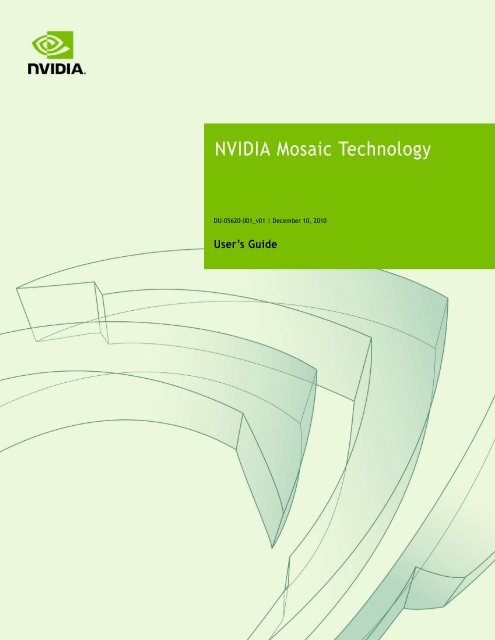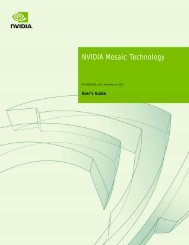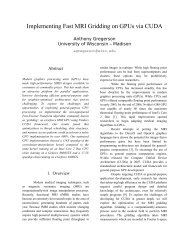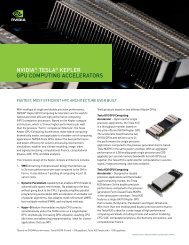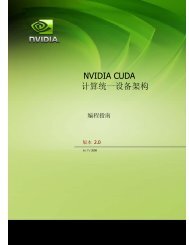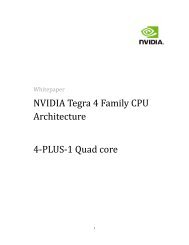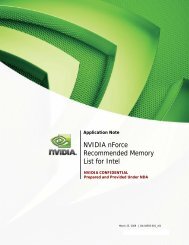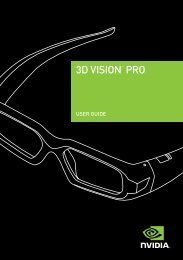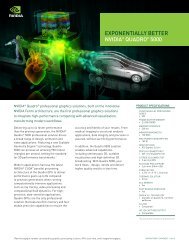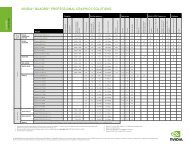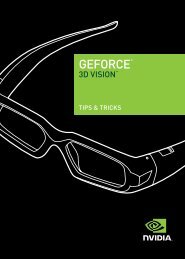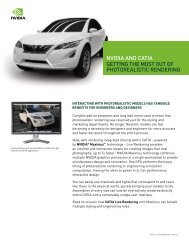NVIDIA Mosaic Technology - PNY
NVIDIA Mosaic Technology - PNY
NVIDIA Mosaic Technology - PNY
You also want an ePaper? Increase the reach of your titles
YUMPU automatically turns print PDFs into web optimized ePapers that Google loves.
<strong>NVIDIA</strong> <strong>Mosaic</strong> <strong>Technology</strong><br />
DU-05620-001_v01 | December 10, 2010<br />
User’s Guide
TABLE OF CONTENTS<br />
1 About <strong>NVIDIA</strong> <strong>Mosaic</strong>............................................................... 1<br />
About This Document ........................................................... 2<br />
System Requirements ........................................................... 2<br />
Limitations........................................................................ 2<br />
2 Using <strong>NVIDIA</strong> <strong>Mosaic</strong> <strong>Technology</strong> ................................................ 4<br />
Connect Your Displays .............................................................. 5<br />
Configure Your Driver Settings .................................................... 6<br />
Configure Display Settings...................................................... 6<br />
Enable V-Sync..................................................................... 6<br />
Set up <strong>Mosaic</strong> Mode ................................................................. 7<br />
Troubleshooting ..................................................................... 9<br />
Display position does not match the diagrams in Appendix A ............ 9<br />
Only 800x600 resolution is available.......................................... 9<br />
Issue ............................................................................ 9<br />
Resolution...................................................................... 9<br />
<strong>Mosaic</strong> options are missing from the Set Up <strong>Mosaic</strong> page ................ 10<br />
Issue ........................................................................... 10<br />
Resolution..................................................................... 10<br />
<strong>NVIDIA</strong> <strong>Mosaic</strong> <strong>Technology</strong> DU-05620-001_v01 | ii
01 ABOUT <strong>NVIDIA</strong> MOSAIC<br />
<strong>NVIDIA</strong>® <strong>Mosaic</strong> <strong>Technology</strong> takes multiple displays and Quadro or NVS GPUs and<br />
presents them as a single logical GPU to the operating system.<br />
In this way, using multiple‐display hardware acceleration, <strong>Mosaic</strong> technology lets you<br />
use multiple displays to create a larger, virtual canvas with minimal performance impact<br />
on 2D or 3D applications.<br />
Each display defines a unique uniform region within a larger virtual canvas.<br />
Figure 1.1<br />
<strong>Mosaic</strong> Regions<br />
Note: Unlike SLI <strong>Mosaic</strong>, <strong>NVIDIA</strong> <strong>Mosaic</strong> does not offer the synchronized<br />
multi-GPU output required for stereoscopic or multi-projector<br />
installations.<br />
<strong>NVIDIA</strong> <strong>Mosaic</strong> <strong>Technology</strong> DU-05620-001_v01 | 1
Chapter 01 : About <strong>NVIDIA</strong> <strong>Mosaic</strong><br />
About This Document<br />
This document explains the <strong>Mosaic</strong> settings and how to connect your displays for<br />
optimum performance.<br />
System Requirements<br />
The following Quadro and NVS products are supported:<br />
Note: If more than one GPU is installed and intended to be used for<br />
<strong>Mosaic</strong>, they must be identical. For example, two Quadro NVS 295<br />
cards can be used in a <strong>Mosaic</strong> configuration, but not one Quadro FX<br />
380 and one Quadro FX 580.<br />
• NVS 300<br />
• Quadro NVS 290, 295, 420, 450<br />
• Quadro FX 380 LP, FX 380, FX 580, FX 1800, FX 3800, FX 4800<br />
• Quadro 600, 2000, 4000<br />
• Quadro 5000, 6000 (non‐SLI <strong>Mosaic</strong> enabled configurations)<br />
• Quadro FX 5800 (non‐SLI <strong>Mosaic</strong> enabled configurations)<br />
• Quadro Plex D2 (non‐SLI <strong>Mosaic</strong> enabled configurations)<br />
• Quadro Plex 7000 (non‐SLI <strong>Mosaic</strong> enabled configurations)<br />
The following operating systems are supported:<br />
• Microsoft Windows 7<br />
<strong>NVIDIA</strong> Quadro Professional Driver Release 265 or newer.<br />
Limitations<br />
Maximum Resolution<br />
The maximum resolution depends on the Quadro product used.<br />
• Quadro 5000/6000, Quadro Plex 7000<br />
These GPUs have a maximum desktop limitation of 16,384 x 16,384 pixels. For<br />
proper operation, do not configure display settings that will total greater than<br />
16,384 pixels in either the horizontal or vertical direction. For example, a 1 x 4 array<br />
consisting of panels of 6400 x 1600 pixel output each would have a total pixel<br />
output dimension of 25,600 x 1600. This would exceed the 16,384 limitation in the<br />
horizontal direction.<br />
• Quadro FX 5800, Quadro Plex D2, all others<br />
<strong>NVIDIA</strong> <strong>Mosaic</strong> <strong>Technology</strong> DU-05620-001_v01 | 2
Chapter 01 : About <strong>NVIDIA</strong> <strong>Mosaic</strong><br />
These GPUs have a maximum desktop limitation of 8192 x 8192 pixels. For proper<br />
operation, do not configure display settings that will total greater than 8192 pixels<br />
in either the horizontal or vertical direction. For example, a 1 x 4 array consisting of<br />
panels of 2560 x 1600 pixel output each would have a total pixel output dimension<br />
of 10240 x 1600. This would exceed the 8192 limitation in the horizontal direction.<br />
The total pixel output for a configuration is the total horizontal pixels by total vertical<br />
pixels. Total size on the Set Up <strong>Mosaic</strong> page calculates the total pixel dimension for you.<br />
The total pixels displayed is a combination of the Display configuration, resolution<br />
setting, and edge overlap settings.<br />
Minimum Resolution<br />
<strong>Mosaic</strong> also requires that individual displays use a resolution greater than 800 x 600<br />
pixel output. If a display in your configuration is set to one of the smaller pixel output<br />
resolutions (e.g., 640 x 480 or 800 x 600), the system will revert to single display mode.<br />
Matching Displays<br />
All displays must be the same type and use the same type of connection (for example,<br />
all DVI‐to‐DVI or all DVI‐to‐VGA). Mixed display use is not supported.<br />
Maximum Number of Displays<br />
• Up to 8 displays, depending on the product and configuration<br />
<strong>NVIDIA</strong> <strong>Mosaic</strong> <strong>Technology</strong> DU-05620-001_v01 | 3
02 USING <strong>NVIDIA</strong> MOSAIC TECHNOLOGY<br />
This chapter describes how to set up your displays and configure the <strong>NVIDIA</strong> software<br />
for <strong>NVIDIA</strong> <strong>Mosaic</strong>.<br />
This chapter explains the three basic stages for setting up SLI <strong>Mosaic</strong> mode, and also<br />
includes a troubleshooting section:<br />
Connect Your Displays<br />
Configure Your Driver Settings<br />
Set up <strong>Mosaic</strong> Mode<br />
Troubleshooting<br />
About the <strong>NVIDIA</strong> Control Panel<br />
• See the <strong>NVIDIA</strong> Control Panel Quick Start Guide for an overview of the interface.<br />
• <strong>Mosaic</strong> settings are found on the Set up <strong>Mosaic</strong> page in your <strong>NVIDIA</strong> Control Panel.<br />
When <strong>Mosaic</strong> is enabled, the Microsoft Windows Display Properties panel will<br />
show multiple displays but you will not be able to interact with them. Instead, use<br />
the settings on the Set up <strong>Mosaic</strong> page to adjust the display resolution and refresh<br />
rate.<br />
<strong>NVIDIA</strong> <strong>Mosaic</strong> <strong>Technology</strong> DU-05620-001_v01 | 4
Chapter 02 : Using <strong>NVIDIA</strong> <strong>Mosaic</strong> <strong>Technology</strong><br />
Connect Your Displays<br />
Connect all the displays that you intend to use in <strong>Mosaic</strong> to the Quadro boards. See<br />
“Display Connections” on page 18 for the proper connectors to use, based on your<br />
solution and display configuration.<br />
All displays connected must be part of the <strong>Mosaic</strong> configuration. For example, the 2x2<br />
configuration cannot be set with only 3 displays connected.<br />
Additional displays that are not part of the desired <strong>Mosaic</strong> configuration should not<br />
be connected, as this may result in unpredictable behavior.<br />
<strong>Mosaic</strong> mode cannot be enabled when only one display is connected.<br />
All displays must be the same type and use the same type of connection (for example,<br />
all DVI‐to‐DVI or all DVI‐to‐VGA).<br />
The visual characteristics of displays vary by manufacturer and model from the same<br />
manufacturer. <strong>NVIDIA</strong> recommends using the same make and model for all displays.<br />
<strong>NVIDIA</strong> <strong>Mosaic</strong> <strong>Technology</strong> DU-05620-001_v01 | 5
Chapter 02 : Using <strong>NVIDIA</strong> <strong>Mosaic</strong> <strong>Technology</strong><br />
Configure Your Driver Settings<br />
There are several settings that you should configure before enabling <strong>Mosaic</strong> mode.<br />
Configure Display Settings<br />
Enable V‐Sync<br />
Configure Display Settings<br />
Before you enable <strong>Mosaic</strong>, only one display is lit. The display settings that you set on this<br />
display will be applied to all the displays after enabling <strong>Mosaic</strong>.<br />
1 Open the <strong>NVIDIA</strong> Control Panel by right‐clicking the desktop and then clicking<br />
<strong>NVIDIA</strong> Control Panel from the context menu.<br />
2 Configure your display settings before enabling <strong>Mosaic</strong>.<br />
Display settings may include but are not limited to:<br />
• Desktop color settings<br />
• Flat panel scaling<br />
• Video and TV settings<br />
Enable V-Sync<br />
1 From the Manage 3D Settings Global presets pull‐down menu, select Base profile.<br />
2 From the Settings list box, select Vertical sync and change its value to Force on, then<br />
click Apply.<br />
3 From the Global presets pull‐down menu, select 3D App ‐ Default Global Settings<br />
(the driver’s default profile) or use the application profile that matches the application<br />
you are using, then click Apply.<br />
<strong>NVIDIA</strong> <strong>Mosaic</strong> <strong>Technology</strong> DU-05620-001_v01 | 6
Chapter 02 : Using <strong>NVIDIA</strong> <strong>Mosaic</strong> <strong>Technology</strong><br />
Set up <strong>Mosaic</strong> Mode<br />
1 From the Select a Task navigation pane, under Workstation, click Setup <strong>Mosaic</strong> to open<br />
the associated page.<br />
Figure 2.1<br />
<strong>NVIDIA</strong> Control Panel Set Up <strong>Mosaic</strong> Page<br />
2 Click the Enable <strong>Mosaic</strong> check box to enable <strong>Mosaic</strong> settings.<br />
3 Under Displays, click the check boxes for the displays that you want to use for <strong>Mosaic</strong>.<br />
Click Identify and the corresponding number appears on your displays to help you<br />
determine which displays you want to check.<br />
4 Under Configuration, select the topology and display orientation you want to use.<br />
The selection must match the number of displays you selected in the previous step.<br />
5 Set the resolution per display.<br />
Click the Resolution (per display) list arrow and then select the resolution to which<br />
you want each display set. Make sure your settings fall within the following limits:<br />
• Maximum total resolution (horizontal or vertical): 8192 for older Quadro products,<br />
16,384 for newer Quadro products. See “Maximum Resolution” on page 2.<br />
• Minimum individual resolution: 800x600<br />
6 Set the refresh rate.<br />
<strong>NVIDIA</strong> <strong>Mosaic</strong> <strong>Technology</strong> DU-05620-001_v01 | 7
Chapter 02 : Using <strong>NVIDIA</strong> <strong>Mosaic</strong> <strong>Technology</strong><br />
Click the Refresh rate list arrow and then select the refresh rate you want applied to<br />
all displays.<br />
Note: The refresh rate list box contains the refresh rates that are<br />
available for the resolution selected. The Set up <strong>Mosaic</strong> page shows<br />
a limited number of refresh rates. For VGA displays, you may not<br />
see a refresh rate that you know is supported. If a refresh rate supported<br />
by your display is not listed, you can set it by locating and<br />
then setting it using the Windows Display Properties page. Alternatively,<br />
you can define a custom mode using the <strong>NVIDIA</strong> Control<br />
Panel->Change resolution page and then the refresh rate should<br />
appear on the Set up <strong>Mosaic</strong> page.<br />
7 Click and drag the icons at the bottom of the page to match your display<br />
configuration.<br />
8 Click Bezel Correction and then adjust the Horizontal and/or Vertical edge gap as<br />
needed to accommodate bezeled displays.<br />
9 Click Apply to save your changes.<br />
<strong>NVIDIA</strong> <strong>Mosaic</strong> <strong>Technology</strong> DU-05620-001_v01 | 8
Chapter 02 : Using <strong>NVIDIA</strong> <strong>Mosaic</strong> <strong>Technology</strong><br />
Troubleshooting<br />
Display position does not match the diagrams in Appendix A<br />
Only 800x600 resolution is available<br />
<strong>Mosaic</strong> options are missing from the Set Up <strong>Mosaic</strong> page<br />
Display position does not match the diagrams in Appendix A<br />
Due to differences in system BIOS configurations with respect to the GPU, the display<br />
positioning on your system may not match the arrangement given in Appendix A.<br />
If this is the case,<br />
Use the “Verify Display” diagrams to determine the correct connections for your<br />
system, and then reconnect the displays accordingly.<br />
If you are using a configuration that does not use all of the display connections on the<br />
Quadro Plex unit and not all of your displays are lit, then connect displays to all of the<br />
connector outputs to determine which outputs are being used.<br />
Only 800x600 resolution is available<br />
Issue<br />
On the Set up <strong>Mosaic</strong> page, only 800x600 is listed under Resolutions (per display).<br />
Resolution<br />
Verify the following and make the necessary corrections:<br />
All displays are the same type–all VGA or all DVI–and that they have the same EDID<br />
information and capabilities.<br />
All the displays are connected to the connector locations as indicated in Appendix A.<br />
<strong>NVIDIA</strong> <strong>Mosaic</strong> <strong>Technology</strong> DU-05620-001_v01 | 9
Chapter 02 : Using <strong>NVIDIA</strong> <strong>Mosaic</strong> <strong>Technology</strong><br />
<strong>Mosaic</strong> options are missing from the Set Up <strong>Mosaic</strong> page<br />
Issue<br />
Some sections are missing from the Set Up <strong>Mosaic</strong> page.<br />
Resolution<br />
1 With the system turned on and the <strong>NVIDIA</strong> Control Panel opened, disconnect (hotunplug)<br />
all displays except for the primary boot display.<br />
2 In the <strong>NVIDIA</strong> Control Panel, select Set up <strong>Mosaic</strong> to open the associated page.<br />
• All appropriate display configurations should appear in the Display setup list.<br />
• Only 800x600 resolution is available.<br />
3 Click the Display setup list arrow and then select the topology you wish to<br />
configure.<br />
The topology should be activated but only the first display will be visible. If VNC is<br />
available, the full topology can be viewed from a remote machine.<br />
4 Connect (hot plug) the remaining displays until all are visible.<br />
The displays may not appear in the proper topology order. This can be corrected later.<br />
5 Enable <strong>Mosaic</strong>, verify the display configuration, and make corrections as needed as<br />
described in “Set up <strong>Mosaic</strong> Mode” on page 7.<br />
<strong>NVIDIA</strong> <strong>Mosaic</strong> <strong>Technology</strong> DU-05620-001_v01 | 10
Notice<br />
ALL <strong>NVIDIA</strong> SOFTWARE, DESIGN SPECIFICATIONS, REFERENCE BOARDS, FILES, DRAWINGS, DIAGNOSTICS,<br />
LISTS, AND OTHER DOCUMENTS (TOGETHER AND SEPARATELY, "MATERIALS") ARE BEING PROVIDED "AS IS."<br />
<strong>NVIDIA</strong> MAKES NO WARRANTIES, EXPRESSED, IMPLIED, STATUTORY, OR OTHERWISE WITH RESPECT TO THE<br />
MATERIALS, AND EXPRESSLY DISCLAIMS ALL IMPLIED WARRANTIES OF NONINFRINGEMENT, MERCHANTABILITY,<br />
AND FITNESS FOR A PARTICULAR PURPOSE.<br />
Information furnished is believed to be accurate and reliable. However, <strong>NVIDIA</strong> Corporation assumes no<br />
responsibility for the consequences of use of such information or for any infringement of patents or other<br />
rights of third parties that may result from its use. No license is granted by implication of otherwise under<br />
any patent rights of <strong>NVIDIA</strong> Corporation. Specifications mentioned in this publication are subject to change<br />
without notice. This publication supersedes and replaces all other information previously supplied. <strong>NVIDIA</strong><br />
Corporation products are not authorized as critical components in life support devices or systems without<br />
express written approval of <strong>NVIDIA</strong> Corporation.<br />
HDMI<br />
HDMI, the HDMI logo, and High-Definition Multimedia Interface are trademarks or registered trademarks of<br />
HDMI Licensing LLC.<br />
Macrovision Compliance Statement<br />
<strong>NVIDIA</strong> Products that are Macrovision enabled can only be sold or distributed to buyers with a valid and<br />
existing authorization from Macrovision to purchase and incorporate the device into buyer's products.<br />
Macrovision copy protection technology is protected by U.S. patent numbers 5,583,936; 6,516,132;<br />
6,836,549; and 7,050,698 and other intellectual property rights. The use of Macrovision's copy protection<br />
technology in the device must be authorized by Macrovision and is intended for home and other limited<br />
pay-per-view uses only, unless otherwise authorized in writing by Macrovision. Reverse engineering or<br />
disassembly is prohibited.<br />
OpenCL<br />
OpenCL is a trademark of Apple Inc. used under license to the Khronos Group Inc.<br />
Trademarks<br />
<strong>NVIDIA</strong> and the <strong>NVIDIA</strong> logo are trademarks or registered trademarks of <strong>NVIDIA</strong> Corporation in the United<br />
States and other countries. Other company and product names may be trademarks of the respective<br />
companies with which they are associated.<br />
Copyright<br />
© 2009, 2010 <strong>NVIDIA</strong> Corporation. All rights reserved.<br />
www.nvidia.com


